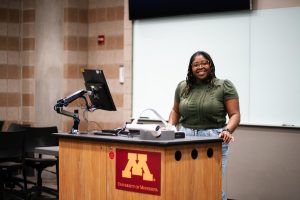In a meeting Monday night, clinic officials discussed the 20 staff positions to be cut from the Community University Health Care Center to help rejuvenate their fiscal progress and keep the clinic out of the red.
Clinic officials chose 20 employees to lay off at their Oct. 2 meeting, but letters to inform them won’t be sent until Nov. 1. While the layoffs might help the clinic financially, not everyone agrees with the move.
The University is the clinic’s second-largest income generator supplying the facility with $600,000 to $700,000 annually.
The clinic was formerly part of the University’s hospital, until the hospital was taken over by Fairview Health Services. At present, the clinic is part of the University’s Academic Health Center.
The Academic Health Center provided a $2.5 million loan to the clinic, and its repayment now prompts the cutbacks.
In addition, according to mandated federal statutes, the clinic’s board is made up of 51 percent community members and clinic patrons, with 49 percent University associates.
Susan Gust, a CUHCC board member and patient, said she understands the restrictions the board is under.
“When the banker gives you an interest-free loan, you tend to please the banker,” she said, referring to the University.
Gust motioned for an emergency meeting that would bring together the board, elected officials, city officials and potential state and local funders sometime before Nov. 1.
At the meeting, possible fiscal alternatives to layoffs would be evaluated. If other means were discovered, a second board-only meeting would be held to discuss the viability of those options.
The motion passed, with just one board member in opposition.
The CUHCC Clinic, located in the Phillips neighborhood, has served low-income and non-insured families with medical and mental health treatment since 1966. The clinic, which runs on a budget of $12 million, is facing a rolling deficit of $2.5 million – something the University said inhibits the functionality of the facility.
Gladys McKenzie, field representative for AFSCME council 75, is concerned about the ramifications of proposed personnel reductions.
“This is a false emergency. The University and (the clinic’s) board should give the staff of the CUHCC clinic the opportunity to save the clinic before thinking about steps to weaken the clinic,” she said, calling the loss of 20 staff members “huge.”
In a news release, McKenzie said if the proposal was passed, “CUHCC will be effectively one step closer to closing its doors.”
The University is seeking to maintain its involvement with the clinic, and that includes keeping the doors of CUHCC open, said Mary Koppel, assistant vice president for public affairs in the Academic Health Center.
“The clinic is important in the long-term,” she said. “We’re doing what we can, and all of this is about keeping the clinic going.”
Koppel said there are several areas in which the clinic must improve to prevent further financial loss.
Ten outreach programs pursued and organized by the clinic were well-minded, she said, but lacked business planning and have thus resulted in a $500,000 loss.
Koppel said the clinic must also increase the number of visitors seeking treatment and services, which she said are far below the standard numbers for community clinics.
Although the CUHCC Board will have the ultimate say, Koppel promised a shift in personnel numbers.
“There will be some layoffs,” she said.
Talk of layoffs has prompted some staff members to pursue positions elsewhere, said Rhonda Jennen, president of AFSCME Local 3260, which represents healthcare workers. She said six positions have been vacated, and the clinic would not fill them. These positions would be part of the quota of 20 to be eliminated.
“There would be serious, serious public health implications following the closing of CUHCC clinic or the reduction of its services,” she said.
Some argue that a potential change in the political landscape could alter funds distributed to the University and eliminate the University’s need to cut positions to compensate for funds now.
“We are three weeks away from elections that could very well alter the political landscape of Minnesota and the country,” said Jim Niland, who along with being a former Minneapolis city council member representing the Phillips neighborhood also serves as political and legislation action director with AFSCME council 5.
Niland said he has seen the threat of closure upon the clinic before, but rallied the surrounding neighborhood, users of the clinic, community allies and elected officials to generate political pressure to keep the clinic’s doors open.







